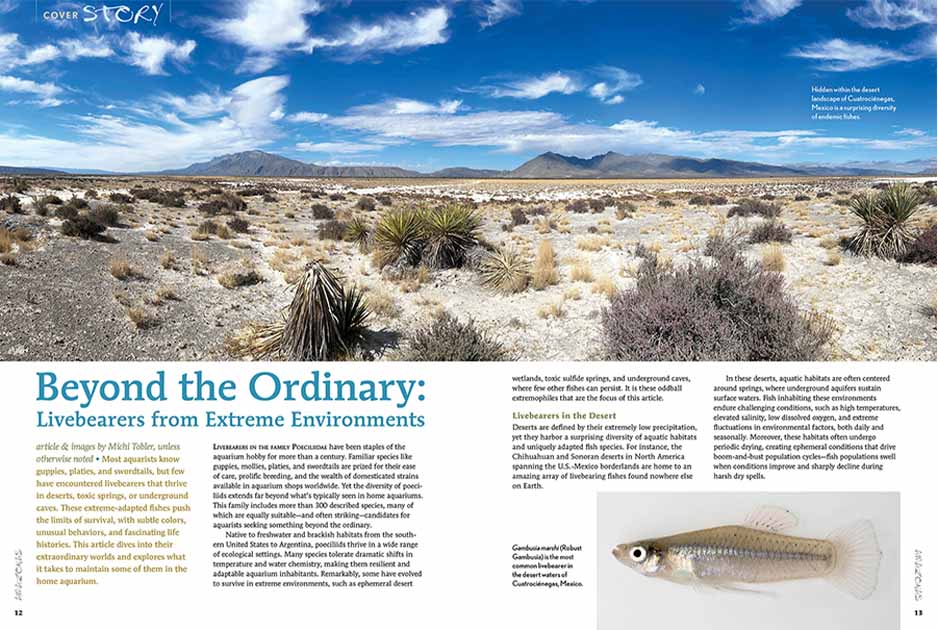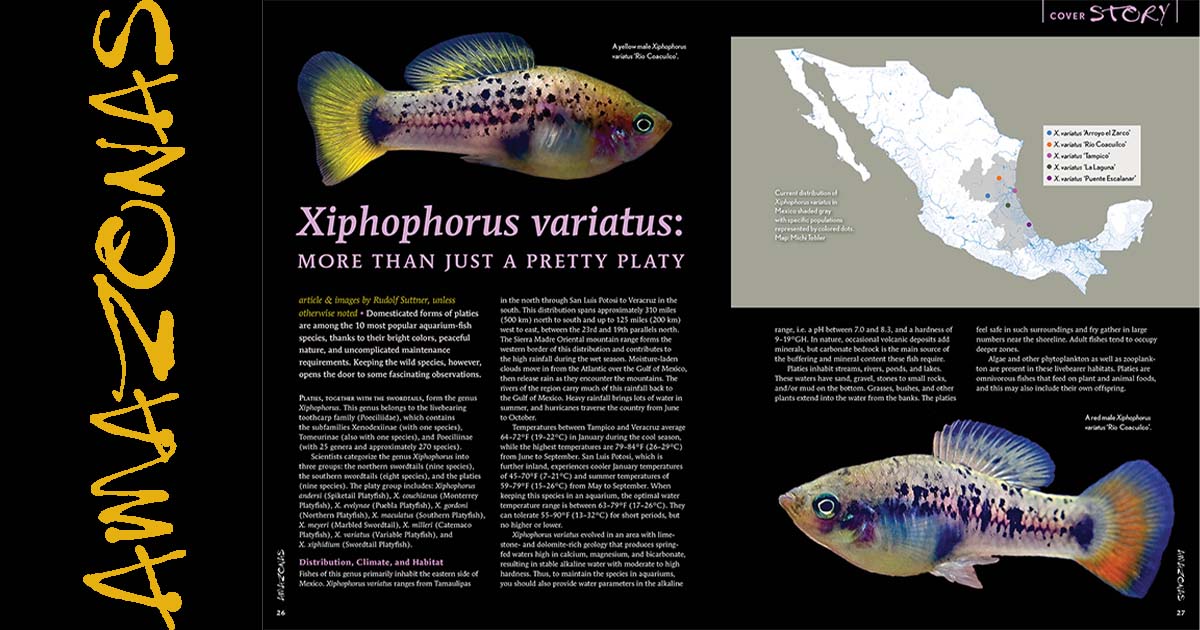Livebearers: Wild & Domestic / AMAZONAS Magazine / November-December 2025 issue marks a significant transition for Editor-in-Chief Courtney Tobler, as she concludes her successful five-year tenure. Tobler’s latest issue is devoted to a topic closely related to her research: livebearing fish, examining their role as examples of evolutionary adaptation and resilience.
Publisher Stephan M. Tanner thanks Tobler for setting “a very high bar” and announces the new editorial team. Alex Rose, a veteran science editor and water advocate known for her work at Coral Magazine, takes over as Editor-in-Chief. Alex is joined by new Associate Editor Jen Williams, an internationally recognized aquascape expert and self-described aquarist known for her focus on biotopes and North American native species.
Aquatic Notebook
In an Aquatic Notebook entry, Flávio Lima pays tribute to the late explorer Heiko Bleher, celebrating his remarkable multilingualism and lasting impact on ichthyology and the aquarium hobby. Lima recalls their first meeting, the humorous debates surrounding the naming of a tetra (Moenkhausia heikoi), and an extraordinary road trip with renowned specialist Jacques Géry.
In recent ichthyological developments, Friedrich Bitter describes Rineloricaria buckupi, a new whiptail catfish species from southeastern Brazil distinguished by its five rows of lateral plates. This species is currently provisionally classified as Least Concern.
Finally, Courtney Tobler reports on two new Betta species from Sumatra, B. iaspis and B. mulyadii, both part of the Betta coccina complex. Due to their extremely limited ranges and intense threat from surrounding oil palm plantations, both new species are proposed to be listed as Critically Endangered.
Beyond the Ordinary: Livebearers from Extreme Environments
Michi Tobler’s article examines livebearers, creatures adapted to extreme environments that most aquarists are unaccustomed to seeing, and may even be shocked to learn exist. It’s hard to believe, but these members of the Poeciliidae family thrive in such improbable habitats as desert springs, toxic sulfide springs, and underground caves.

Tobler explains how desert livebearers cope with high temperatures, salinity, and volatile conditions in places like Cuatrociénegas in Mexico and Bitter Lake in the US. For example, Gambusia marshi and the critically endangered Xiphophorus gordoni are among these species. He notes that they can be challenging to maintain in aquariums and may require seasonal cooling.
The article then focuses on even more extreme species, such as sulfide spring livebearers, which thrive in waters that are toxic and oxygen-depleted due to hydrogen sulfide gas.
Xiphophorus Variatus: More than Just a Pretty Platy
Rudolf Suttner’s article provides valuable and surprising information on the care and breeding of wild populations of Xiphophorus Variatus compared to popular domesticated species, and notes that these livebearers evolved in the alkaline and hard waters of Mexico and require similar aquarium parameters.
The key to successful breeding, as recommended by experienced breeders, was the strategy of high stocking densities in large aquariums (450 L and above) and the presence of other fish to distract the females.
Remember, the behavior of these fish in the aquarium is very different from that of their domesticated counterparts! This article is a must-read for anyone looking to push the boundaries of livebearer breeding!
Fish Breeding: Maintaining Genetic Health
Diana Walstad’s article addresses the often-overlooked issue of genetic deterioration in aquarium fish, focusing on the root causes of lost vitality and shortened lifespan in Fancy Guppies (Poecilia reticulata). Walstad highlights three key genetic barriers: inbreeding (which reduces fitness under stress), outcrossing (which can cause outbreeding depression in F2 generations), and age truncation (where breeding only young fish leads to the loss of longevity genes).
The article details Walstad’s extensive selective breeding studies, which have successfully restored her guppy lineage from five months to 12−18 months. This extensive research highlights the importance not only of aquarium conditions but also of genetic health. This extensive research highlights the importance not only of aquarium conditions but also of genetic health, which is fundamental for hobby sustainability.
Dermogenys Siamensis: A Small Halfbeak From Thailand
This field report by Anton Lamboj highlights the subtle allure of Thailand’s surface-dwelling Dermogenys siamensis (Half-Beak). The author notes that this livebearing species is easy to breed, but as always, one of the main challenges in the aquarium hobby is accurate identification (due to the similarity of the species) and the parents’ tendency to cannibalism.
The most critical finding in Lamboj’s paper is the female’s ability to store sperm, meaning she can continue producing offspring even after the male has left the aquarium. A surprising evolutionary adaptation.
Reportage: A Spotted Beauty: Caridina SP. ‘Dalmat’
Sebastian Wolf’s article introduces Caridina sp. ‘Dalmat’, a striking wild dwarf shrimp rarely seen in the aquarium hobby and whose scientific identity has yet to be determined. Also known as the “Chinese Princess Bee,” this species features a unique color pattern consisting of large reddish spots and typically five to seven white transverse bands on a bluish-white body.
Wolf recommends keeping this small shrimp, approximately 2.5 cm long, in aquariums with dark substrates and low-conductivity (GH+) water produced by remineralized reverse osmosis. While Caridina sp. ‘Dalmat’ tolerates a simple setup, he emphasizes that their minimalist diet should be supplemented with live foods and bacterial mixtures. Wolf also notes that their breeding experience showed females produce only one clutch during their short lifespan, highlighting the difficulty of maintaining populations.
Reportage: Etia Nguti: An Endemic Cichlid of Southwestern Cameroon
Michel C.W. Keijman’s report describes the cichlid Etia nguti, a monotypic species native to the upper Cross River basin in West Africa. Described in 2003, this species inhabits the clear, cool (22-28°C), soft, and shady rainforest streams of Cameroon, where its natural coloration provides effective camouflage.
Keijman recommends setting up an aquarium of at least 400 L with a gentle current and group hiding places. He notes that E. nguti is omnivorous and accepts flake/pellet foods, as well as frozen and live food supplements. He also notes that this species is a mouth-brooding larva and that, while generally peaceful, males become territorial during the breeding season. As always, I recommend reading Livebearers: Wild & Domestic / AMAZONAS Magazine November-December 2025 issue to learn more about this creature’s feeding habits and its housing.
Reportage: An Electric Blue Jewel from Lake Malawi: Sciaenochromis Fryeri
Wolfgang Staeck’s article paints a compelling portrait of the Electric Blue Hap (Sciaenochromis fryeri) from Lake Malawi, from its taxonomic confusion to its surprisingly easy care. The author highlights the species’ long history of misidentification and its suitability for aquarists.
He notes that S. fryeri, a mouth-brooding broodstock, is easy to breed but requires a minimum aquarium volume of 280 liters (75 gallons). Staeck also believes that the rarity and high cost of this relatively easy-to-raise species stem from the difficulty of selling females and fry in the trade due to their lack of attractiveness.
Husbandry and Breeding: The First Successful Breeding of Glossamia Wichmanni
Dong Hoon Lee’s article comprehensively describes the first successful aquarium breeding of Glossamia wichmanni (Wichmann’s Mouth Almighty), a rare and little-known freshwater cardinalfish native to New Guinea.
Lee notes that this remarkable mouthbrooder can spawn even in a relatively small aquarium of 120 liters (40 gallons), but recommends adding structural elements such as plants and wood to stabilize the males. He also clearly explains the reasons for G. wichmanni’s notoriously difficult breeding and how to overcome them. It’s difficult to cover the entire process in this short review, but here’s a quick tip: artificial hatching of the eggs is unlikely.
Lee also concludes that once this initial breeding challenge is overcome, the species is easy to raise, thanks to its low cannibalism rate and large appetite. This article is a must-read for any aquarist exploring the limits of fish farming.
Husbandry and Breeding: Breeding the Freshwater Pipefish Enneacampus Ansorgii
Roland Morte’s article examines the unique biology of the African Freshwater Pipefish (Enneacampus ansorgii), which, similar to its seahorse relatives, reproduces through male gestation (incubation of eggs in the male’s pouch). Morte emphasizes that this species’ slow feeding habits require a species-specific aquarium with high water hardness and alkalinity.
While breeding is simple, the biggest challenge is raising the fry. Morte details his significant finding that the survival rate for these little wingless dragonets reached 10%, an achievement he outlines in the Livebearers: Wild and Domestic / AMAZONAS Magazine November-December 2025 issue. The article concludes that E. ansorgii is a fascinating and manageable species for dedicated aquarists, despite its constant demand for live food.
Husbandry and Breeding: The Blackworm Breeder Box Method: One Hobbyist’s Breakthrough in Culturing Blackworms
Mandy Goan’s article offers a practical solution for the small-scale cultivation of Blackworms (Lumbriculus variegatus), one of the most expensive and difficult live foods in the aquarium hobby.
Goan emphasizes that the worms primarily reproduce through segmentation and warns that the leading cause of culture crash is overfeeding, advising consumption within 48 hours. Goan’s simple and scalable system now allows hobbyists to grow their own nutritious live foods affordably.
Livebearers: Wild & Domestic / AMAZONAS Magazine
AMAZONAS Magazine is one of the world’s leading print publications for the freshwater aquarium industry. If you’d like to subscribe and read all the content, you can start your subscription here. You can find the previous issue, Curious Catfish / AMAZONAS Magazine / September / October 2025, here. We’re eagerly awaiting the next issue!
Cover Photo: N Akvaryum
References:
- AMAZONAS Magazine / Last Access Date: 08.09.2025 / https://www.amazonasmagazine.com/
If you have also read the Livebearers: Wild & Domestic / AMAZONAS Magazine November-December 2025 issue, please share your opinions and evaluations about this issue with us and other aquarists in the comment section below.
Whether you are a beginner hobbyist or an experienced aquarist, don’t hesitate to open your own thread and ask your questions on the Aquarium Forum for help, advice, or guidance. We are here for you and happy to help.
Frequently Asked Questions (FAQ)
Can I subscribe to AMAZONAS Magazine from any country?
AMAZONAS Magazine only accepts PayPal as a payment method. You can find the list of countries where PayPal is accepted here.
If I start my AMAZONAS Magazine subscription, in which language will I receive the magazine?
Your magazine will be delivered in English. However, you can easily read it in your preferred language using a browser like Google Chrome, using the designated panel.


